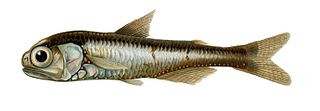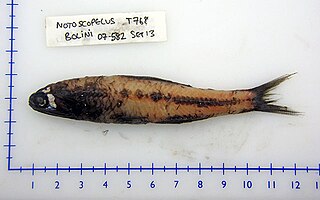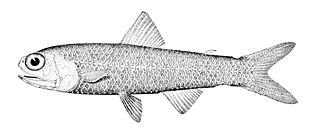
Deep-sea fish are fish that live in the darkness below the sunlit surface waters, that is below the epipelagic or photic zone of the sea. The lanternfish is, by far, the most common deep-sea fish. Other deep-sea fishes include the flashlight fish, cookiecutter shark, bristlemouths, anglerfish, viperfish, and some species of eelpout.

The swim bladder, gas bladder, fish maw, or air bladder is an internal gas-filled organ that contributes to the ability of many bony fish to control their buoyancy, and thus to stay at their current water depth without having to expend energy in swimming. Also, the dorsal position of the swim bladder means that the expansion of the bladder moves the center of mass downwards, allowing it to act as a stabilizing agent in some species. Additionally, the swim bladder functions as a resonating chamber, to produce or receive sound.
The mesopelagiczone, also known as the middle pelagic or twilight zone, is the part of the pelagic zone that lies between the photic epipelagic and the aphotic bathypelagic zones. It is defined by light, and begins at the depth where only 1% of incident light reaches and ends where there is no light; the depths of this zone are between approximately 200 to 1,000 meters below the ocean surface.

Lanternfish are small mesopelagic fish of the large family Myctophidae. One of two families in the order Myctophiformes, the Myctophidae are represented by 246 species in 33 genera, and are found in oceans worldwide. Lanternfishes are aptly named after their conspicuous use of bioluminescence. Their sister family, the Neoscopelidae, are much fewer in number but superficially very similar; at least one neoscopelid shares the common name "lanternfish": the large-scaled lantern fish, Neoscopelus macrolepidotus.

Pelagic fish live in the pelagic zone of ocean or lake waters—being neither close to the bottom nor near the shore—in contrast with demersal fish that live on or near the bottom, and reef fish that are associated with coral reefs.

Argyropelecus hemigymnus, the half-naked hatchetfish, short silver hatchetfish or spurred hatchetfish, is a deep-sea hatchetfish of the genus Argyropelecus found mesopelagically in the Atlantic, Indian, and Pacific Oceans as well as in the Mediterranean Sea. It is a small species rarely exceeding 38 millimetres (1.5 in) standard length. It feeds on zooplankton, particularly ostracods and copepods. Sexual maturation occurs at length of about 22 mm, and adult males have more developed olfactory organs than females, i.e. the species is sexually dimorphic.

Warming's lantern fish, Ceratoscopelus warmingii, is a lanternfish of the family Myctophidae, found circumglobally in both hemispheres, at depths of between 700 and 1,500 m during the day and between 20 and 200 m at night. Its length is about 8 cm (3.15 in).

The deep scattering layer, sometimes referred to as the sound scattering layer, is a layer in the ocean consisting of a variety of marine animals. It was discovered through the use of sonar, as ships found a layer that scattered the sound and was thus sometimes mistaken for the seabed. For this reason it is sometimes called the false bottom or phantom bottom. It can be seen to rise and fall each day in keeping with diel vertical migration.

The Antarctic lanternfish or Electrona antarctica mainly inhabits the Antarctic deep, warm waters. It is the dominant species in the Southern Ocean. Their life span is about 4–5 years and they mature after 2–3 years. Their maximum length is 12.5 cm. Their feeding depends upon area to area. Small fish primarily feed on copepods, euphausiid larvae, and hyperiids. This species is mainly the nektonic prey species of seabirds in open water. It is an important krill predator and serves as prey for a majority of seabirds. It is one of the southernmost fish species, being recorded as far south as 74°40′S in the Ross Sea.

Myctophum punctatum is a species of mesopelagic fish in the family Myctophidae. Its common name is spotted lanternfish, sometimes spelled spotted lanterfish. It is found in the Northern Atlantic and in the Mediterranean at depths down to 1000m. It is one of the dominant species in midwater assemblages near the Mid-Atlantic Ridge.

Benthosema glaciale, or glacier lantern fish, is the most common species of lanternfish and important part of the midwater ecosystem of northern North Atlantic.

Notoscopelus bolini is a species of lanternfish in the family Myctophidae. It is found in the North Atlantic Ocean and the Mediterranean Sea. It was first described in 1975 by the American ichthyologist Basil Nafpaktitis and named in honour of the American marine biologist Rolf Ling Bolin who had reviewed the genus in 1959.
Lampanyctus festivus is a species of lanternfish. It is found in the Atlantic, Indian, and Pacific Oceans. It is a mesopelagic fish that undertakes diel vertical migration. It grows to about 14 cm (5.5 in) standard length. It is an important component in the diet of forkbeard Phycis phycis off the Azores.

Lampadena speculigera is a species of lanternfish in the subfamily Lampanyctinae. It is a mesopelagic fish that is found in the Atlantic, Indian, and Pacific Oceans. Its vernacular name is mirror lanternfish.

The headlight fish is a species of lanternfish in the family Myctophidae. It is also sometimes referred to as the headlight lanternfish, or even the lanternfish, though it is not the only species to be called this.

Symbolophorus evermanni is a species of fish in the family Myctophidae. It is widely distributed in the Indian and Pacific Oceans. The specific name evermanni honors ichthyologist Barton Warren Evermann. It is also known as Evermann's lanternfish or Evermann's lantern fish.
Benthosema fibulatum is a species of fish in the family Myctophidae. It is a meso- to bathypelagic species found in the Indian and Pacific Oceans. It grows to 10 cm (3.9 in) total length.
A micronekton is a group of organisms of 2 to 20 cm in size which are able to swim independently of ocean currents. The word 'nekton' is derived from the Greek νήκτον, translit. nekton, meaning "to swim", and was coined by Ernst Haeckel in 1890.

The white-spotted lantern fish, also called Rafinesque's lanternfish, is a species of fish in the family Myctophidae.
Diaphus vanhoeffeni, also known as VanHoffen's lanternfish, is a species of lanternfish found in the eastern Atlantic Ocean.















